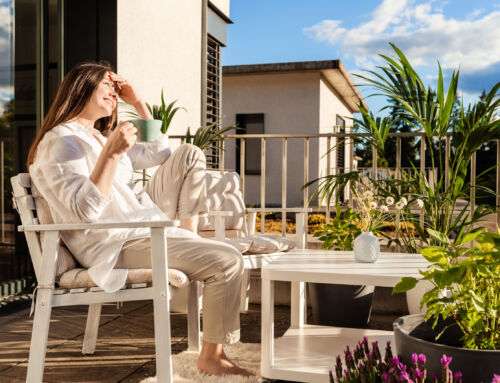“Going green” is no longer a trend, but a responsible, sustainable, necessary way of living. In fact, there are countless ways to ‘green up’ your life when you make a few simple and fairly small changes to how you live.
You don’t have to rebuild your home and invest in high-tech additions to make a difference in your energy footprint; all you have to do is make an effort to change the way your home operates. Often, making eco-friendly changes will benefit your budget as well! There’s nothing wrong with being more conscientious and saving your hard-earned money at the same time.
1) Recycling and composting
You know about the recycling and composting programs available in Alberta, but are you using them? Most cities and towns have a blue bin pickup program, and you can make recycling even easier by making sure to have a bin inside your home too. The kitchen is a natural place for recyclables, but you can store them inside the garage, or at the back door too.
Familiarize yourself items that can and cannot be recycled; for instance, check the bottom of plastic containers for a recycling symbol; if it has one, it’s safe to add to the recycling bin. Some symbols have a number inside of them as well; you can learn more about plastic types for recycling in Alberta here.
As for composting, you can find small bins that fit under your sink; put in food and kitchen waste, paper and even pet hair! If you’re using a backyard composter, try to avoid meat, cooking oil, bread and dairy products, as they can attract pests.
2) Reduce your water consumption
Low-flow fixtures are widely available now, and can drastically reduce water consumption in an average home. But you don’t have to rely on your fixtures to reduce waste; you can make small changes in the way you use water every day as well, like washing your clothes in cold water, turning off the tap when you’re brushing your teeth or shaving. Of course, if those same fixtures are leaking, fixing them quickly can help reduce waste as well.
For your yard, consider a rainwater barrel. An extended rain shower can result in well over 500 litres of fresh water running from your roof, and into the sewers. A rain barrel can collect enough to water an average lawn and garden many times over.
3) Consider solar power
Solar panels can drastically reduce the average residence’s power consumption, and it’s becoming easier to access and install them all the time. You don’t have to completely ‘go off the grid’ to make your home greener and more energy efficient; buying or leasing solar panels can reduce your electricity consumption, and your burden on the system.
4) Use energy-efficient appliances
According to recent data, the average electricity bill for an Alberta home is $167 per month. Add in natural gas or other utilities and the cost to power and heat our homes increases even more.
Energy-efficient appliances are just that; appliances that have been designed to use the minimum amount of energy required, whether water, gas or electricity. From stoves to fridges and other items throughout your home, the familiar blue ‘Energy Star’ logo means that you have one of the most efficient appliances available to reduce costs and energy bills. You can learn more about Energy Star products in Canada here.
5) Think about a programmable thermostat
We all know that we should be turning the heat (or the air conditioning) down in our homes when we’re at work or asleep, but let’s be honest, it’s tough to remember to do it every day.
You can take the guesswork out of this task by investing in a programmable thermostat to regulate your home’s temperature according to a set schedule. While there may be an initial cost to buying a new thermostat, the savings will quickly add up.
Cutting your energy consumption while also saving money? That’s a win-win.
6) Switch to energy-saving light bulbs
This one’s really easy; simply switch older incandescent light bulbs to LED or fluorescent bulbs.
Almost 10% of your home’s electrical consumption is from light bulbs. New bulbs are not only more energy-efficient, but they have a very long lifespan as well; they can last almost 25 times longer than old-fashioned ones.
LED or fluorescent bulbs also produce less heat when switched on, meaning you’re actually helping to keep your home cool during the warmer months.
7) Cut out paper
We’re all aware that paper can be recycled, but it’s now possible to go almost entirely paperless when it comes to utility bills and statements. Most energy providers offer account services online, and it’s no secret that paying online can help keep your payments on-time and well-organized. The same goes for banks, credit cards, investments and dozens of other services you use daily.
8) Green your garden
One of the easiest (and tastiest) ways to green your home is to plant a garden. Even in a small space container garden, you’ll be taking steps towards increasing nutrition, physical activity and mental health while also cutting bills.
Setting up a composting station in your yard recycles kitchen and food waste, reduces landfill waste, produces organic nutrients for your soil and reduces the need for chemical fertilizer. It doesn’t have to be fancy and can be an aerated, fenced-in wood box or a commercial tumbler bin.
In your yard, selecting native plants and grasses is usually best, as they are adaptive to the environment. Watering has come a long way, with automated, controlled sprinklers, seep hoses, and irrigation systems.
9) Style is natural
Consideration for the environment doesn’t mean your home can’t be beautiful. Kitchens and bathrooms are highlights of the home and the most important rooms for value and re-sale. Choice of materials for stunning counter tops make a difference, so it’s a great idea to search for beautiful, sustainable solutions like recycled glass, quartz and bamboo.
Carpets and flooring are another place to reduce your waste footprint and invest in stylish, eco-friendly alternatives such as bamboo flooring, engineered hardwood, corkwood, marmoleum, and wool-based carpets.
Love shabby chic? Reclaimed and barn wood options bring a cozy, antiqued and re-purposed look and feel. Consider reclaimed and salvaged wood for ceiling beams, fire mantels, millwork, counters and more.
10) It’s the little things
Finally, you can always find small ways to help the environment and cut down on your waste in the home;
- Switch from paper towels to cloth towels that can be washed and reused
- Switch to bio-degradable laundry and dish detergents
- Use bars of soap instead of liquid soap with all its associated packaging
- Switch to reusable filters for making your morning pot of coffee
- Unplug any electrical appliances you’re not using
- Invest in cloth napkins instead of disposable paper ones
- Change your old batteries to rechargeable ones
- Say no thanks to plastic cutlery when you get takeout
It’s really that easy! Going green doesn’t require inconvenient and expensive lifestyle changes, there are actually so many inexpensive, simple adjustments to significantly shrink your carbon footprint. Enjoy the process, and be proud of your efforts! You’re making a difference.
The content provided in this blog is for general information purposes only and nothing contained herein should be taken or relied upon as legal advice. Although every effort is made to ensure the accuracy of information shared on this blog, the information may inadvertently contain inaccuracies.







Connect